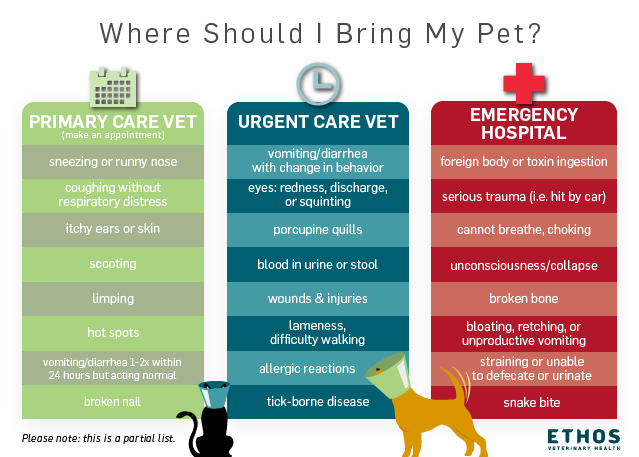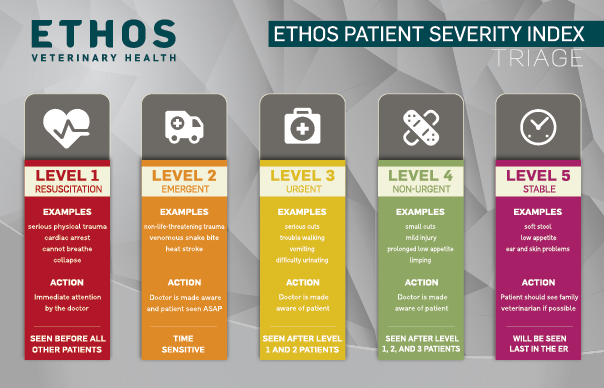Vet Urgent Care: Know When to Go
When a person is sick, we have several treatment options for medical care. We know when to go to an emergency hospital vs. an urgent care clinic, and when to wait and see our PCP. This wasn’t the case in veterinary medicine until recently. Now, veterinary urgent care clinics are popping up in more and more places. As a pet owner, it’s important to understand what options are available near you so you can be prepared in the event your dog or cat needs you to spring into action.
A veterinary urgent care clinic should be considered as an adjunct service to critical care emergency hospitals and primary care veterinarians. The list below is incomplete, but it covers some of the more common emergencies and conditions that should be seen by each of these different groups of veterinary medical care facilities.

Click to enlarge graphic
How do Veterinary Urgent Care Clinics Work?
Most urgent care clinics work by appointment. They are open later during the day and into the evening, offering pet owners an extension to their regular veterinarian’s day. Pets in stable condition that can’t wait to get an appointment with their regular veterinarian should be seen at an urgent care clinic. Having an appointment eliminates the need to wait at a busy emergency room when your pet is uncomfortable, but stable.
Patient Severity Index
Emergency veterinary hospitals triage and treat patients based on severity of their condition. A patient who needs medical care, but who is less severe than a pet in life-threatening condition, will be asked to wait.
At an urgent care clinic, all patients are stable, so your pet will be seen at their scheduled appointment. Meanwhile you can wait more comfortably at home, knowing your pet will get the care he or she needs. This can reduce stress and anxiety for everyone, including your pet.
5 Tips for Getting the Most out of an Urgent Care Visit
- The team in our urgent care department will work with you and your regular veterinarian to provide the comprehensive care your pet needs. If you have recently seen your family vet for the same medical condition, or if your pet has other medical conditions or is on medication, please ask your doctor to forward your pet’s medical record. This step is not required but it might save time and money, especially if they have to repeat recent diagnostic tests.
- Urgent care centers treat patients that are between 3 – 5 on the Patient Severity Index excluding those that require surgical intervention. Veterinary emergency rooms work just like their human counterparts. Patients of all levels of illness and injury require care and our teams must help them in order of need. The Patient Severity Index (PSI) shows how we make those decisions.
- Call ahead and describe your pet’s symptoms if you are not sure of his or her condition. A member of the urgent care team will give you an estimated arrival time based on capacity, remaining appointment slots, and your pet’s condition. In some cases, you may be diverted to a local ER.
- If a pet arrives at urgent care that is in need of medical attention that the urgent care cannot provide, the medical team will stabilize the pet for transfer to a veterinary emergency hospital.
- Veterinary urgent care medical teams are comprised of experienced veterinarians and technicians with extensive training in emergency and urgent veterinary care. The clinics have limited diagnostic and therapeutic equipment, often only radiography (x-rays) and point-of-care ultrasounds. Most veterinary urgent care clinics do not have a surgical suite or surgical equipment on-site, so they cannot perform surgery in the clinic. Skip the urgent care if you think your pet needs surgery urgently.
